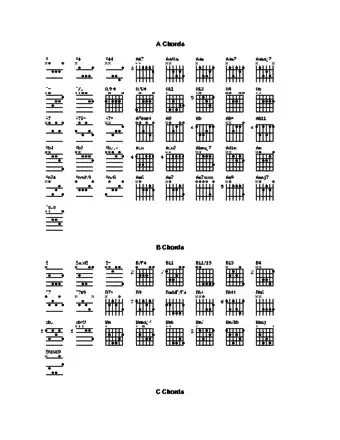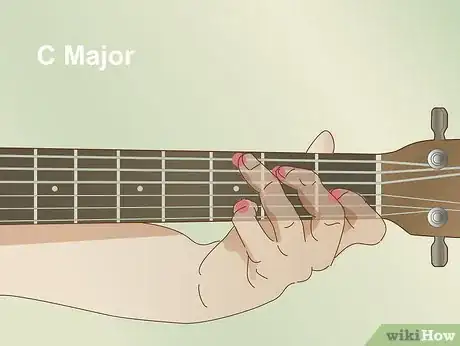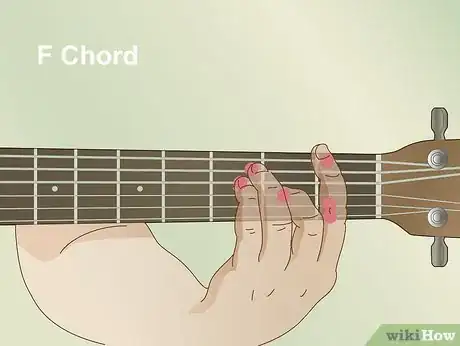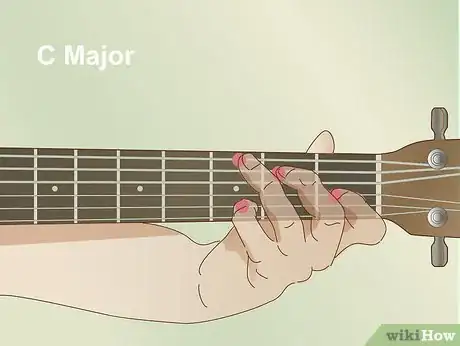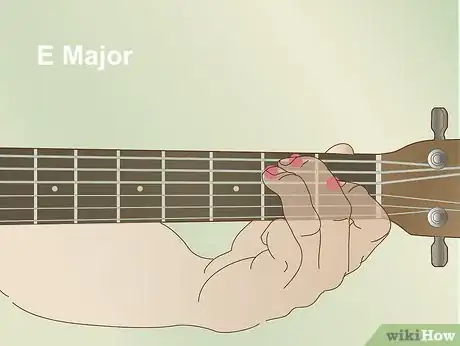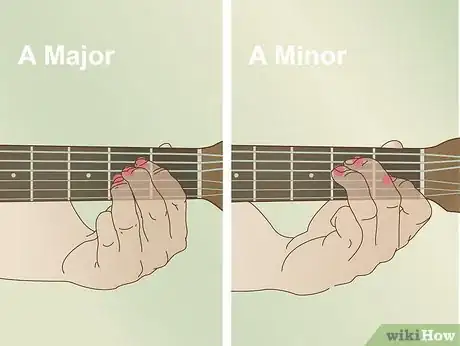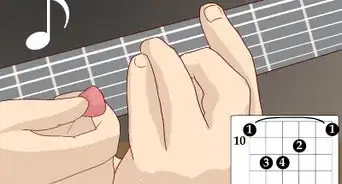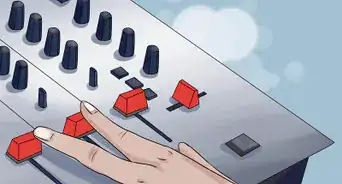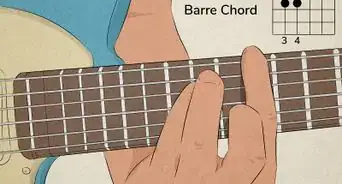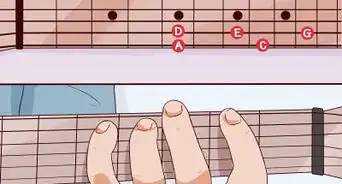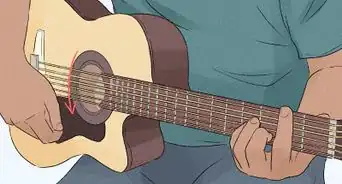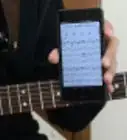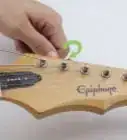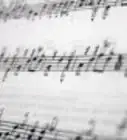This article was co-authored by Aaron Asghari. Aaron Asghari is a Professional Guitarist and the lead guitarist of The Ghost Next Door. He received his degree in Guitar Performance from the Guitar Institute of Technology program in Los Angeles. In addition to writing and performing with The Ghost Next Door, he is the founder and primary guitar instructor of Asghari Guitar Lessons.
There are 7 references cited in this article, which can be found at the bottom of the page.
wikiHow marks an article as reader-approved once it receives enough positive feedback. This article received 22 testimonials and 85% of readers who voted found it helpful, earning it our reader-approved status.
This article has been viewed 2,027,867 times.
Learning to play guitar is loads of fun, though playing chords may seem a little intimidating at first. Fear not, it is not much different than playing single notes: you're just playing them all at once! This article will walk you through the process of working out the fingering, and show you how to play some common chords. Pull out your axe, and rock on!
Steps
Sample Chord Chart and Guitar Help
Understanding Chords
-
1Learn the strings. The best way to start is by becoming familiar with the strings on your guitar and how they relate to your fingers.[1] To make this easier, we're going to number them both. The strings on your guitar are numbered like this:
- Vertically, the strings are numbered 1 through 6, from highest pitch to lowest.
- Horizontally, the numbering is based on the fret positions.
- Note that when the directions say "put your first finger on the 3rd fret," that means you actually place your finger between the 2nd and 3rd fret. It's the string itself that needs to be in contact with the 3rd fret.
Use this mnemonic to remember which note each string is tuned to, from lowest pitch (top string) to highest pitch (bottom string):
Eat All Day, Get Big Easy.[2] -
2Number your fingers. Take a look at your left hand, and imagine you have numbers stamped on your fingers. Your index is 1, your middle finger is 2, your ring finger is 3, and your pinky finger is 4. Your thumb we will call "T," but you will not be using it for chords in this article.Advertisement
-
3Learn the C chord. The first chord we will cover is a C chord—one of the most basic chords in music. Before we do, let's break down just what that means. A proper chord, whether played on a piano, a guitar, or sung by well-trained mice, is simply three or more notes sounded together. (Two notes is called a "diad," and while musically useful, is not a chord.) Chords can also contain far more than three notes, but that's well beyond the scope of this article. This is what a C chord looks like on the guitar:
- The lowest note is the 3rd fret of the A string: C
- The next note up is played on the 2nd fret of the D string: E
- Note there is no finger on the G string. This string remains "open" when strumming a C.
- The highest note is played on the 1st fret of the B string: C
- The highest and lowest strings on the guitar are not played for the basic C major chord.
-
4Try it out the notes. Play each note in the chord, from low to high, one at a time. Take your time and be deliberate: press down firmly on the fret, and pluck the string. Let the note ring for as long as you can, then move to the next note:
- Press your 3rd finger onto the 3rd fret of the A string, as indicated above, pluck, and let it ring until it fades out. You just played a C note.
- Press your 2nd finger onto the 2nd fret of the D string, then do the pluck-and-ring to play an E.
- Break time! Simply pluck the open, un-fingered G string.
- Press your 1st finger on the 1st fret of the B string, and let that C note sound loud!
- Play the notes, one at a time, for a few times. When you're ready, sweep your pick or fingers across all four middle strings quickly. You've just played a C chord!
- It may sting a little the first few times you do it, but as you develop calluses, the pain goes away.
Learning More Chords
-
1Expand your musical vocabulary. Playing a C chord is nice, and it's definitely a gateway chord that will lead you into more interesting musical territory, but there's much more to music than that! Here are two other chords commonly used when playing in C Major. F, and G. Play a basic F chord like this:
- The notes in an F chord are F, A, and C. Note that the F and the C are being played by the same finger: the first finger is placed across the 1st fret of both the 1st and 2nd strings.
- Generally, chords are built so that the lowest note is the root of the chord, but in this case, the F is being sounded on the 1st fret of the 1st string. This is called an "inversion."
-
2Extend the F chord. You can an F in the root by playing the F on the D string: the 3rd fret up, played with your third finger. You may notice the chord doesn't sound a lot different, just "fuller."
-
3Play a G chord. Like the C and the F, the G chord is one of the Big Three in the C major scale. There are many ways to play it, and we'll show you two. The first way is easy: it's the exact same fingering as the extended F chord, only moved up two frets:
-
4Play the G chord the easy way. Here's a way to play the G chord with only one finger:
-
5Put it all together. Now that you know the three basic chords in the key of C, put them together, and perhaps you'll recognize about a zillion popular songs. Strum C four times, followed by F, two times, then G, two times, then back to C.
- Note that after each chord is a Roman numeral. These indicate what position the root note of the chord is on the scale—regardless of fingering. Once you know the basic chords in all the keys, it's easier to just show a chart than to have the chord spelled out every time.
- Practice that until your fingers are tired, then take a break, but come back: we'll also show you the basic chords in E and A!
-
6Learn the key of E. There's a lot of rock 'n' roll done in the key of E, and a lot of blues, too. The three chords to learn here are E Maj (I), A Maj (IV), and B Maj (V). Here's the E chord:
- This is one of the easier chords to play, once you have your calluses built up. You can play all the strings at once. Crank up a Marshall stack to 11 with this chord, hit it hard, and you'll feel the beginnings of being a rock hero!
-
7Play the A Major. This is another "big chord," sonically. There are several ways to play this. You can use one finger across the 2nd fret of the B, G, and D strings (playing C#, A, and E, respectively), or any other combination of fingers. For this example, we'll use the 4th finger on the B string, 3rd finger on the G string, and 2nd finger on the D string.
- As you get better at playing, you will understand that moving quickly from one chord to another sometimes results in odd fingerings that still work. The key is to make the most efficient use of your fingers, and once you kick off the training wheels, don't be afraid to experiment.
-
8Play the B Major. You can play this one easy, or play this one hard. The easy way is shown with the black numbers. You can add the additional note, show by the gray number.
-
9Try it out. Here's another short strumming pattern to try out in the key of E:
- Try varying your strumming pattern, too: don't just stick to the lines on the paper.
-
10Learn the key of A. You're already two thirds of the way there! The key of A consists of A in the first position (I), D in the fourth position (IV), and our old powerhouse friend E in the dominant fifth position (V). Here's how to play the D chord:
- Note the first finger across the first three strings: this is the beginning of a "barre" chord. A full barre chord uses one finger across all strings, and is often based on the basic forms shown in this article.
-
11Learn an alternate version of the A chord. This is useful when played along with the D and the E chords:
-
12
Using Video Chord Diagrams
-
1Learn a G major. Your ring finger goes on the top string, 3rd fret. The middle finger is for the 5th string, 2nd fret, and you pinky goes all the way to the bottom, on the 3rd fret of the 1st string. Strum all of the strings together to play the chord. If you want, add in the 3rd fret, 2nd string -- this not is not necessary, but makes a richer sounding chord.
- --3--
- --0--
- --0--
- --0--
- --2--
- --3--
-
2Learn a C major. Place your ring finger up on the 5th string, 3rd fret. Then follow with your middle finger 4th string, 2nd fret -- note how this is the same beginning as a G chord, just moved down a string. Then end with your index finger on the 2nd string, 1st fret. Play all but the top string.
- --0--
- --1--
- --0--
- --2--
- --3--
- --X--
-
3Learn a D major. This chord only requires the bottom four strings. Place your index finger on the 3rd string, 2nd fret. Your ring finger then goes on the 2nd string, 3rd fret, and your middle finger is the 1st string, second fret. You'll form a little triangle shape. Only strum these three strings and the 4th string -- the open D -- to sound out the chord.[5]
- --2--
- --3--
- --2--
- --0--
- --X--
- --X--
-
4Learn an E minor and major. This deep chord uses all six strings. Place your middle and ring fingers on the 2nd frets of the 4th and 5th strings. Then place your index finger on the 3rd string, 1st fret. Strum all six strings.
- --0--
- --0--
- --1--
- --2--
- --2--
- --0--
- Make an E-minor chord by simply removing your index finger, leaving the 3rd string open.[6]
-
5Learn an A Major and minor. An A major is one of your easiest chords -- simply use your index, ring, and middle finger to fret the 2nd fret on the 2nd, 3rd, and 4th strings. Play every string but the low-E string.
- --0--
- --2--
- --2--
- --2--
- --0--
- --X--
- Make an A-minor chord by playing the first fret, not the second, on the B string. The shape is identical to E-major.
-
6Learn an F major. F resembles a C major chord, just smushed. Ignore the top two strings. Place your ring finger on the 4th string, 3rd fret. Your middle finger goes 3rd string, 2nd fret. Finally, the index finger goes on the 2nd string, 1st fret. Play only the bottom four strings.
- --0--
- --1--
- --2--
- --3--
- --X--
- --X-- [7]
Expert Q&A
Did you know you can get expert answers for this article?
Unlock expert answers by supporting wikiHow
-
QuestionHow do I teach myself to learn music theory?
 Aaron AsghariAaron Asghari is a Professional Guitarist and the lead guitarist of The Ghost Next Door. He received his degree in Guitar Performance from the Guitar Institute of Technology program in Los Angeles. In addition to writing and performing with The Ghost Next Door, he is the founder and primary guitar instructor of Asghari Guitar Lessons.
Aaron AsghariAaron Asghari is a Professional Guitarist and the lead guitarist of The Ghost Next Door. He received his degree in Guitar Performance from the Guitar Institute of Technology program in Los Angeles. In addition to writing and performing with The Ghost Next Door, he is the founder and primary guitar instructor of Asghari Guitar Lessons.
Professional Guitarist & Instructor
-
QuestionHow can I cope with the excruciating pain on my fingertips after playing?
 Community AnswerPractice more to fully develop callouses. Some people put glue on their fingertips, but this is a very temporary solution, and will end up hindering your playing in the long run.
Community AnswerPractice more to fully develop callouses. Some people put glue on their fingertips, but this is a very temporary solution, and will end up hindering your playing in the long run. -
QuestionHow can I be fast on chord changes?
 Community AnswerStart slow, and make your changes perfect, then begin to speed up. Work up slowly.
Community AnswerStart slow, and make your changes perfect, then begin to speed up. Work up slowly.
Warnings
- As Ringo Starr shouted after a grueling studio session, "I've got blisters on me fingers!", you will get blisters, and your fingers will hurt. As guitarist George Harrison noted, "all things must pass." So, too, shall the blisters, to be replaced with calluses. Practice often, and before long you won't be bothered with finger pains again.⧼thumbs_response⧽
References
- ↑ Aaron Asghari. Professional Guitarist & Instructor. Expert Interview. 15 February 2019.
- ↑ http://www.theguitarlesson.com/guitar-lesson-blog/beginner-guitar-lessons/guitar-string-mnemonic-acronyms/
- ↑ Harmony by Walter Piston, 3rd Edition
- ↑ Jazz Harmony by Andy Jaffe, 2nd Edition
- ↑ Aaron Asghari. Professional Guitarist & Instructor. Expert Interview. 15 February 2019.
- ↑ http://www.guitarlessons.com/guitar-lessons/guitar-lessons-for-beginners/play-10-songs-with-4-chords/
- ↑ http://www.guitarlessons.com/guitar-lessons/guitar-lessons-for-beginners/8-guitar-chords-you-must-know/
- Videos from GuitarLessons.com
About This Article
To play a C chord on a guitar, put your ring finger on the third fret on the A string, your middle finger on the second fret on the D string, leave the G string open, and put your index finger on the first fret of the B string. Before you try to strum the chord, play each note individually until the note sounds clear. When you've mastered the C chord, try moving on to other chords like G or F. To see a guitar chord chart and learn how to connect different chords together, read on!
